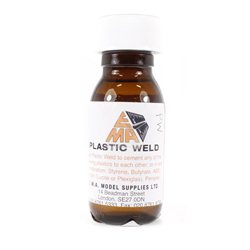Historically, a group of wagons connected together and forming a train was often referred to as a "rake." This term...
No products
Product successfully added to your shopping cart
There are 0 items in your cart. There is 1 item in your cart.
Search Tips
Christmas and New Year
We are dispatching orders every weekday apart from Christmas Day, Boxing Day and New Year's Day.
If you order is time critical, select next day delivery at checkout.
The shop in Sandown is closed from 25th December, reopening on 30th December.
What is Plastic Weld?
Plastic Weld from EMA is an indispensable adhesive for scale modellers and hobbyists working with plastic kits. Its unique properties make it a go-to solution for achieving strong, seamless bonds between plastic parts, ensuring your models look professional and withstand the test of time. If you're passionate about precision and durability, understanding how Plastic Weld works can elevate your modelling projects.
Unlike general-purpose glues, Plastic Weld is a solvent-based adhesive. It doesn’t just stick pieces together—it chemically bonds them. When applied, the solvent softens the surface of the plastic, essentially "melting" it. Once the solvent evaporates, the softened surfaces fuse, creating a single, robust piece of material. This makes it ideal for thermoplastics commonly used in modelling, such as polystyrene, ABS and acrylic.
The bond created by Plastic Weld isn’t just strong; it’s permanent. This means you can trust it to hold even under stress or varying temperatures, which is crucial if your models are displayed in fluctuating conditions. Additionally, the chemical bonding eliminates visible seams when done correctly, giving your models a cleaner and more polished finish.
Plastic Weld is also designed with the modeller in mind, offering precision during application. You use it with a fine brush or applicator, allowing you to control exactly where the adhesive goes. This is particularly useful for intricate parts of a model, where precision is essential to avoid messy spills or damage to the surrounding areas.
Using Plastic Weld does require a bit of care. As it involves solvents like dichloromethane or methyl ethyl ketone (MEK), it can emit strong fumes. Always work in a well-ventilated area or wear appropriate protective gear, such as a respirator mask. Additionally, since it chemically alters the plastic, mistakes can be difficult to undo, so practise on scrap materials before working on your prized model kits.
The versatility of Plastic Weld extends beyond simple bonding. Experienced modellers often use it for customising and scratch-building projects. By softening plastic edges, you can manipulate and reshape parts, giving you more creative freedom in your designs. Whether you're repairing broken components or adding unique details, this adhesive can be a powerful tool in your modelling arsenal.
In summary, EMA's Plastic Weld is more than just glue—it's a transformative adhesive that enables scale modellers to achieve durability and precision in their projects. With proper use, it ensures that your models look professional and stay intact for years. So next time you're planning your next masterpiece, consider Plastic Weld as your adhesive of choice.
Click here to receive the tips weekly in your mailbox. You can unsubscribe at any time.








